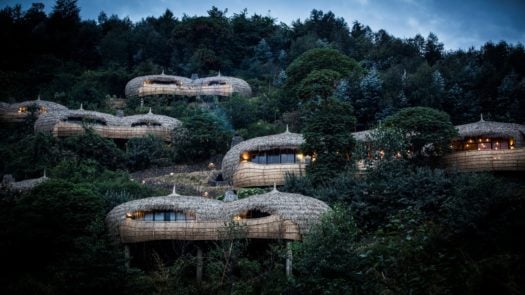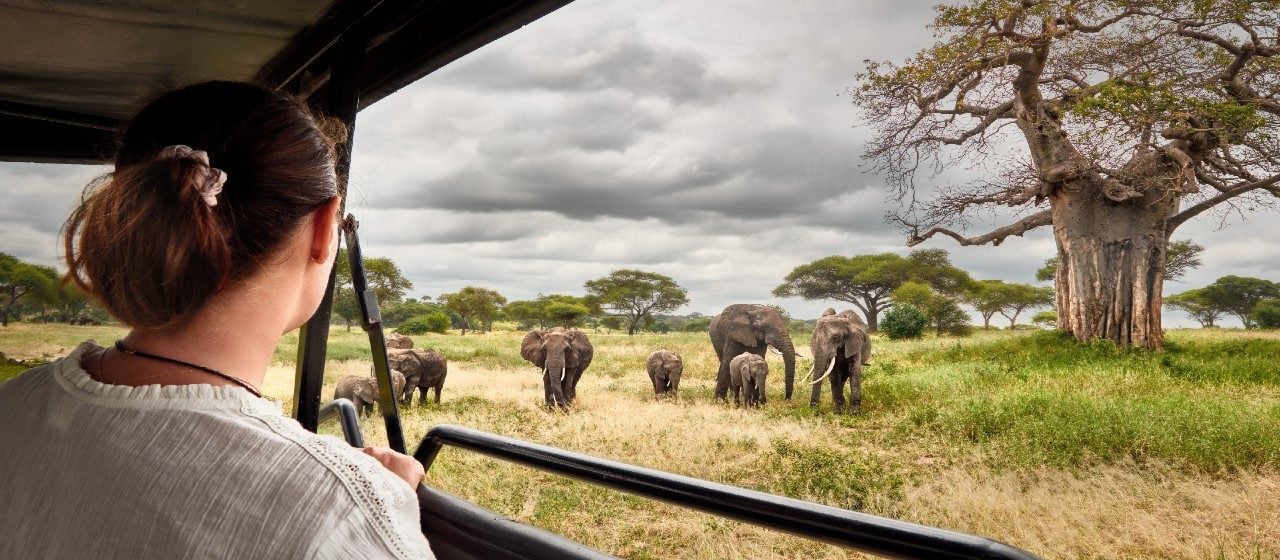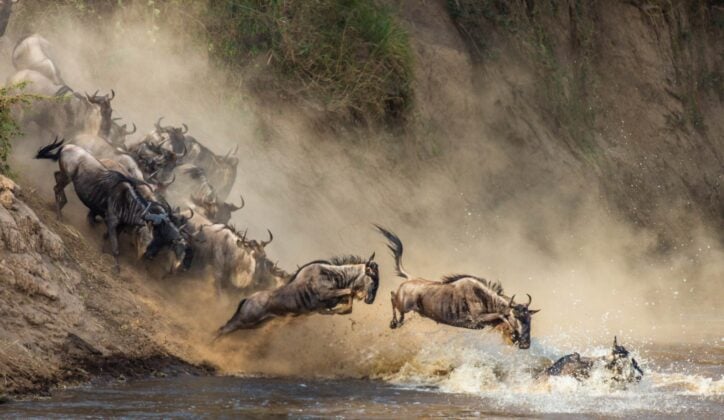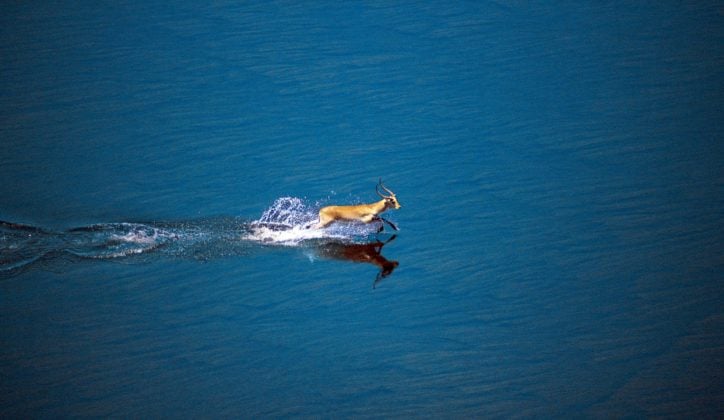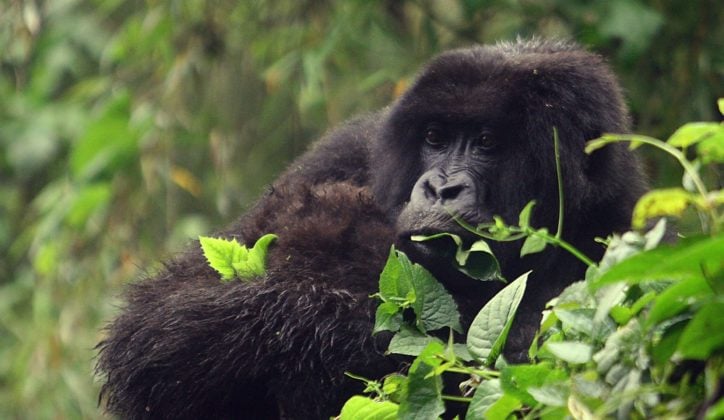Published on: February 15th, 2022
Last modified: March 20th, 2024
The beautiful continent of Africa is justifiably famous for its wilderness, and as landscapes go, there aren't many other places that offer so much variety. Its wildlife-rich savannahs are where lions, elephants, giraffes and many more species still roam free. It also hosts the iconic annual Great Migration, where millions of wildebeest sweep through the Maasai Mara in Kenya, making their way to the Serengeti in Tanzania. The best way to experience this vast continent’s many wonders is by going on a safari. But with so many amazing destinations in Africa, it’s hard to narrow down where the best place is for the most rewarding safari.
In this curated pocket guide, we bring you the best African safari destinations according to our team of expert travel designers. Among them are the Kruger National Park in South Africa, ideal for first timers to get acquainted with the South African safari scene; the Okavango Delta for more adventurous travellers; and Rwanda for those after gorilla trekking safaris amid endless green hills.
The continent is so diverse that there’s destination to suit every taste and every type of traveller, whether it’s a safari in East Africa or Southern Africa.
And when you’ve seen the best of Africa, our team of experts is ready to help you plan your next safari adventure. This time to Australia.

Best Safari for Each Type of Traveller
Best African Safari for Families
For families, South Africa is a good introduction to the continent’s wildlife. It boasts well-known wilderness areas and parks like the Kalahari, Kruger National Park and Sabi Sands, in which you’ll find a variety of family-friendly safari camps.
When it comes to travelling with the whole family, the ideal destination is one that is child-friendly in general as well as in terms of places to stay. We recommend Tswalu Reserve in The Kalahari Reserve. The fact that there’s no risk of malaria here makes the location great for families. Another draw is its exclusivity, since only 30 guests are allowed in the entire Tswalu reserve at one time.
South Africa is also a good option for families looking to do more than just go on safari. You can escape from city to beach life in the blink of an eye, tour vineyards today and be whale watching tomorrow. Beyond South Africa’s borders, there are many other incredible luxury safari lodges for families to discover, one of our team’s favourites being Giraffe Manor in Kenya.
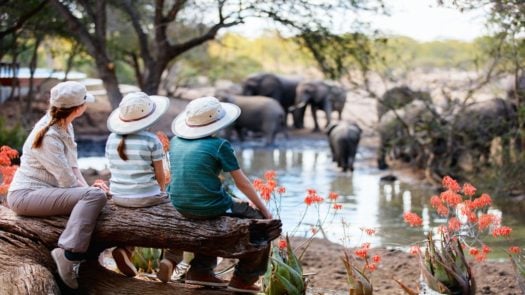
Best African Safari for Older Travellers
The Mara Conservancies in Kenya are a great option for more mature travellers. The area offers an exclusive safari experience with exceptional wildlife viewing. The conservancies here also restrict the maximum number of guests and rooms, ensuring fewer visitors and ultimate privacy during game drives.
With a limited number of camps permitted in the conservancies, tourism is lower impact and more sustainable. Base yourself at Angama Mara for the ultimate Out of Africa experience. From here, you have access to the Maasai Mara, home to one of Mother Nature’s greatest shows. Between July and October, millions of wildebeest thunder through during the Great Migration. There’s also the Mara River where you can spot some of the world’s biggest crocodiles.
Besides going on safari, there’s a wide range of activities such as visits to the Maasai tribe, picnicking on the romantic ‘Ngong Hills’ where scenes for 1985’s ‘Out of Africa’ were filmed, or go on a hot-air balloon ride and take in spectacular views of the valley from above. There are also countless ways to unwind and relax, with in-room massages being just one.
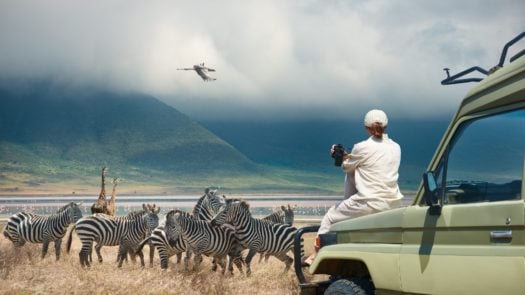
Best First Time Safaris
If it’s your first time going on a safari to Africa, South Africa is your best bet, while Namibia comes in a close second. In South Africa, natural reserves such as Kruger National Park and Sabi Sands give you a good introduction to African wildlife.
Sabi Sands in particular, is widely regarded as Africa’s premier game reserve, and it is world renowned for its abundance of game, particularly leopards. There is also Kruger National Park which is best known for being one of the oldest and largest wildlife reserves in the world. Our pick of the local lodges is Singita Lebombo, an intimate, upscale property with a spacious deck from which you can enjoy stunning views of Singita’s Kruger Concession.
As with South Africa, our travel designers also recommend Namibia for new visitors to Africa. During the dry season between July and October, Etosha National Park transforms itself into a magnet for wildlife as animals gather around the remaining water. For first time families and older travellers, the lush terrains of the Onguma and Ongava Private Game Reserves offer an all round excellent, more exclusive and intimate wildlife experience.
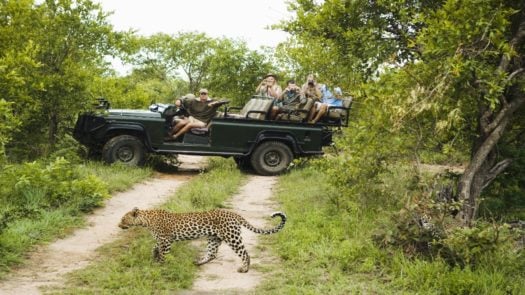
Best Safaris for Experts
For safari experts, East Africa comes highly recommended. Kenya and Tanzania are dotted with private concessions that are lesser-known, yet truly rewarding. They also feature some of the finest safari lodges in Africa. Gorilla trekking in Rwanda is another experience to put on the list.
You could look for primates while on an adventure in the lush jungles of Volcanoes National Park. Alternatively, experience the exclusivity of the Mara Conservancies in Kenya. Or why not bring a unique twist to your traditional safari experience by combining it with a climb to the summit of Mount Kilimanjaro in Tanzania. The Eastern part of the continent is sure to introduce you to a side of Africa you’ve never seen before. Our travel designers can help you plan the perfect trip.
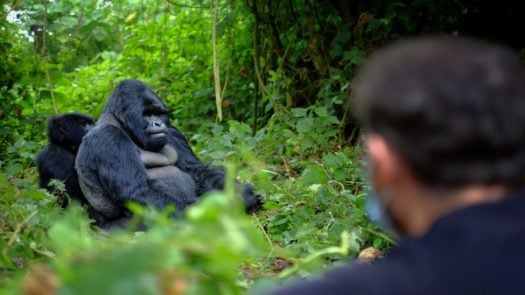
Best Adventure Safari in Africa
Botswana and Tanzania are some of the best places in Africa for adventure safaris as outdoor enthusiasts are able to experience the thrill of mobile camping. On a mobile safari expedition, you journey through some of the most remote areas while following the game.
The Okavango Delta and the Serengeti National Park, in particular, offer exceptional mobile camping experiences at the heart of nature. In contrast to permanent tented camps, mobile safaris move into new territory every two to three days. This is done by the crew while you are out on game drives during the day. A mobile safari expedition brings you to some of the most untouched areas of wilderness, often with very few other visitors around. It is also one of the best ways to spot animals in their natural environments.
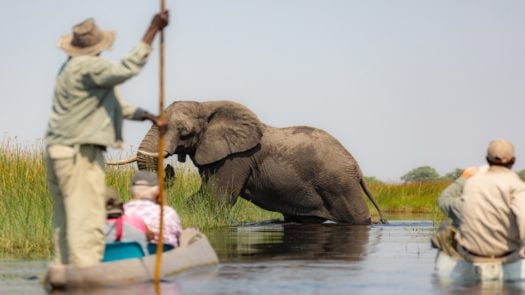
Our Team's Favourite Safari Trips to Africa
Top Safari Destinations
The Best African Safari Countries
1. Kenya
Kenya is one of the best safari destinations in the world. It is home to the world-renowned Maasai Mara National Park where the Big Five and other animal species roam freely. It is also where you can see the iconic Great Migration and its dramatic river crossings.
Every year, huge herds of wildebeest, zebra and antelope, travel around the Serengeti in Tanzania and into the Maasai Mara. The animals follow the pattern of the rains, closely watched by an array of predators. The best time to go on safari in the Maasai Mara is during the dramatic river crossings. Many of the herds can be seen crossing the border from Tanzania and into Kenya’s Maasai Mara National Park. Crossings at the Mara River take place from August to October. However, natural events such as this can never be guaranteed. While this time of the year marks the peak season for migration safaris, it may take weeks for the herds to finally cross the crocodile infested waters. This is why we recommend booking your safari to Kenya with the help of our experienced team. Our travel designers love nothing more than creating bespoke safari itineraries.
For those seeking a more exclusive safari experience, the Mara Conservancies bordering the Maasai Mara National Park offers exceptional game viewing and far fewer visitors.
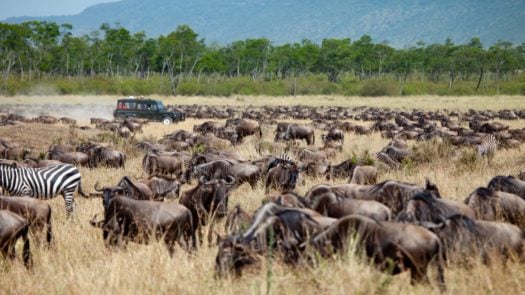
2. Tanzania
One of Africa’s best known safari destinations is Tanzania. The East African country is filled with a breathtaking array of wildlife across its multiple natural reserves like Singita Grumeti. Tanzania also offers unparalleled wildlife experiences at its Serengeti National Park during the Great Migration.
The landscape in Tanzania offers a different kind of safari. Magnificent plains stretch seemingly endlessly and its volcanic craters teem with wildlife. What also makes the destination unique is the possibility of combining a safari trip with a hike up the mighty Mount Kilimanjaro.
Read when is the best time to visit Tanzania here.
While you can see the Great Migration in both Kenya and Tanzania, the herds spend most of the year in Tanzania. Visiting Tanzania during the ‘Green Season’ between late January to early February allows you to experience the birth of the wildebeest. Approximately 8,000 calves are born each day during the birthing season, in close proximity to the Ngorongoro Crater area. Going on safari in Tanzania during this time of the year promises an action-filled adventure as this is when it’s easier to spot predators. The peak safari season in Tanzania spans from July to October when most river crossings take place. But it is easier to escape the crowds in Tanzania. Some of Africa’s finest safari camps are located in its reserves, many of which offer exclusive traversing rights to the game.
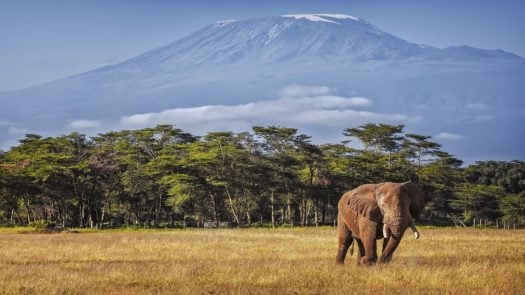
3. South Africa
South Africa is home to one of the oldest and most iconic national parks in the world. Kruger National Park is where you can spot the Big Five and many other species of African wildlife. South Africa is the best safari destination for families and first-timers.
A year-round destination, South Africa provides a good introduction to the safari world. Sabi Sands particularly, is regarded as Africa’s premier game reserve. It shares borders with Kruger National Park, allowing visitors to experience close encounters and remarkable wildlife sightings, particularly of leopards. The Sabi and the Sand Rivers running through the reserve also attract an array of animal species.
In South Africa, the unique desert-looking Kalahari attracts herds of herbivores as well as their predators and some of Africa’s rarest wildlife. This is also where you can find the malaria free Tswalu Reserve, housing two accommodation options that allow for a maximum of 30 guests at a time.
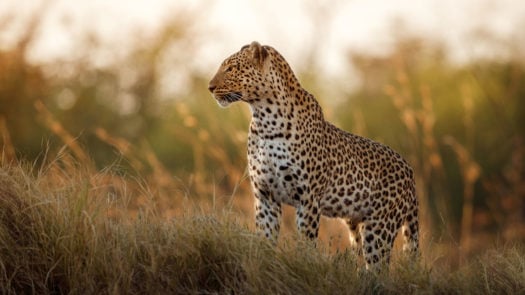
4. Botswana
In Botswana, you can experience more than just traditional game drive safaris. The country is home to the Okavango Delta and Chobe River where you can go on water safaris. The lagoons and rivers also extend to the Linyanti where a large abundance of predators roam free.
Botswana is one of the best African safari destinations for adventure travellers. The landlocked country offers endless opportunities to experience wildlife like never before. You can go on a mobile safari expedition and discover the most untouched parts of Botswana as you follow the game. You can also take a helicopter ride and marvel at the beauty of the Okavango Delta from above.
In the Moremi Game Reserve, you can experience the unique combination of land and water. One of the best ways to explore the area is onboard a mokoro canoe. You can expect to see a wide variety of species ranging from rhinos, giraffes and lions to some 500 different types of birds. Add to this the northeast’s Chobe National Park, known for its massive elephant herds.
The predator capital of Africa can also be found in Botswana. Mombo Concession offers some of the best wildlife viewing, a place where you can spot the Big Five. We recommend you base yourself at Mombo Camp.
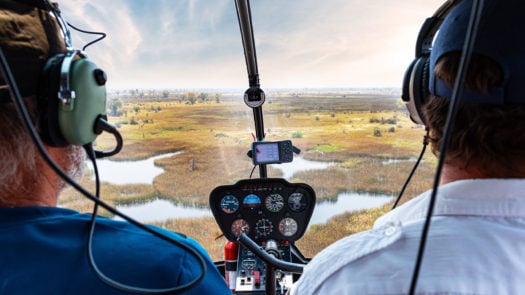
5. Namibia
Namibia is filled with innumerable sights. Its otherworldly landscapes consist of sweeping dunes, dramatic views and unspoiled nature. Home to a rich population of cheetahs, Namibia offers matchless wildlife viewing. It is also a destination that is great to visit all year round.
Not many people immediately think of Namibia when planning a safari experience in Africa, but that’s what makes the region so special. In Namibia, you will find the world’s oldest desert, the Namib, home to some of the most fascinating desert-adapted wildlife. If you want to see as many of these animals as possible, June to October is the best time to visit Namibia. During this dry season, animals gather at the remaining watering holes, making it easier to spot them. You can expect to see zebras, elephants, springbok and gemsbok.
Namibia is perhaps best known for the rust-red sand dunes of its Sossusvlei, but the country is also dotted with national parks, private reserves and concessions teeming with incredible wildlife. The best places to go on safari in Namibia are Etosha National Park and Damaraland. Etosha’s limitless horizon in particular, is a haven for photographers. Adding to its beauty are lions, elephants and wildebeest. Etosha also offers remarkable birding, species like eagles, harriers, falcons and vultures call it home. Besides going on safari, Namibia offers endless opportunities for adventure. Here are the top things to do in Namibia other than going on game drives.
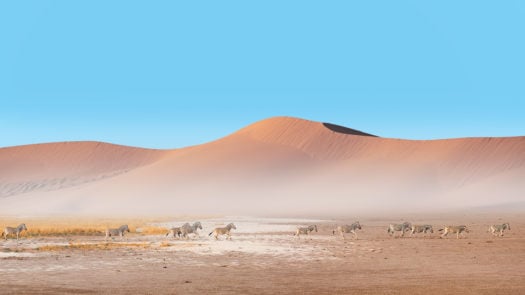
6. Rwanda
Rwanda is among Africa’s best safari destinations. It is one of the few places in the world where you can encounter mountain gorillas. These giant primates can be found in Volcanoes National Park. In Akagera National Park you can see lions, leopards, giraffes and more.
Rwanda, Uganda and Congo are three African countries where you can still find endangered mountain gorillas. In Rwanda itself, the population of this species stands at approximately 880 individuals. Today, researchers continue to study the conservation of these creatures. The Fossey Fund is the world’s longest-running and largest organisation dedicated entirely to the conservation of gorillas. By 2022, Rwanda expects to see the world’s first permanent, purpose-built gorilla research and education centre.
And while the celebrities in Rwanda are none other than the fascinating gorillas of Volcanoes National Park, there is also Nyungwe Forest National Park, home to a vast array of primates like chimpanzees and offering remarkable birding opportunities. While in Rwanda, Akagera National Park is also worth a stop. You can see iconic African wildlife, including elephants, rhinos, giraffes, zebras and more.
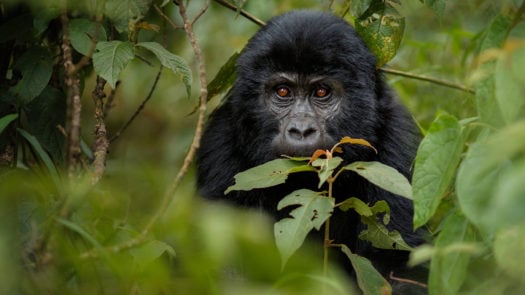
7. Zimbabwe
Zimbabwe is an African destination that offers incredible safari experiences. Its Hwange National Park is one of the best places in the world for viewing large herds of elephants. Zimbabwe’s Mana Pools is a UNESCO-protected national park filled with wildlife, with some of the best predator actions.
While Zimbabwe has long been the star of African safaris, these recent years have seen a greater interest in other destinations like Kenya, Tanzania and Botswana due to accessibility. But Zimbabwe remains one of the best places for game viewing, even more so with the resulting thinning of crowds.
In Zimbabwe, you can get up close with some of the region’s endangered species. Hwange National Park in particular is heaving with elephants. It is also home to one of the largest populations of African wild dogs. There are over 100 mammals and 400 different bird species. You can even spot the Big Five here.
There’s also Mana Pools. Its low scrub makes for an excellent walking safari destination and the pools are perfect for canoe-based game spotting. Keep an eye out for Nile crocodiles.
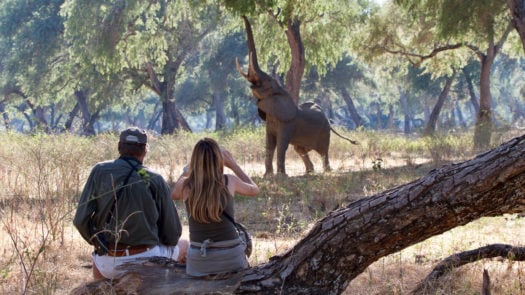
8. Uganda
Uganda is made up of dense forests, pristine landscapes and abundant wildlife. Bwindi Impenetrable Forest is where you can get up close to endangered mountain gorillas, and in Queen Elizabeth National Park you can spot tree-climbing lions. Uganda hosts the highest concentration of primates on Earth.
But while gorilla-filled jungles are the main attraction, this African destination is also revered for its untamed, non-touristy safaris through endless savannah plains. The landlocked country offers off-the-beaten-path experiences and world-class safari lodges in some of the world’s most remote locations.
Both Rwanda and Uganda offer incredible gorilla trekking. That said, Uganda comes out tops for those who see themselves as a little more adventurous. If you’re still undecided between Rwanda and Uganda for gorilla trekking, we have done a full comparison here.
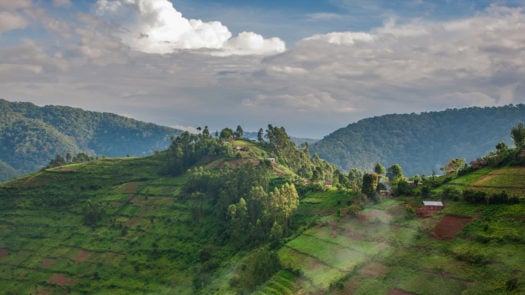
Where to go on safari throughout the year
Where to Go on Safari between January and March
January to March marks the ‘green season’ in the southern Serengeti. February is the best month to go on safari in Tanzania. This is the peak birthing season, with around 400,000 wildebeest born each year. The wet season is also great for birdwatching.
Going on a safari in Tanzania during this time of the year promises an action-filled adventure as this is also the peak season for predators. During this period, you are likely to spot a high concentration of lions, cheetahs, leopards and raptors on the hunt for young wildebeest.
Uganda is another African destination that’s great to visit in January and February. While visitors usually come to Bwindi Impenetrable National Park for gorilla trekking, there are still plenty of opportunities to experience the traditional safari experience at Queen Elizabeth National Park, home to vibrant wildlife.
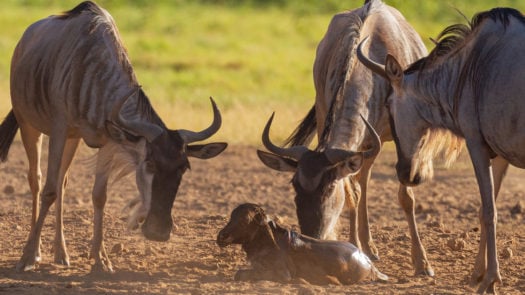
Where to Go on Safari between April and June
The best time to visit Kruger National Park in South Africa is during the dry season beginning in May. During this period, the weather conditions are ideal, the bush thins out and with fewer waterholes, animals will congregate at those that remain. This is the perfect time for wildlife viewing.
Our travel designers also recommend visiting Namibia during this period. Although it is a great place to visit all year round, the best time to visit for wildlife viewing begins in June. That’s when animals start to congregate at watering holes as water becomes scarce. This means you have more chances to spot large herds. In Damaraland for instance, you can see desert elephants from the month of May. The area is home to a collection of game reserves and concessions.
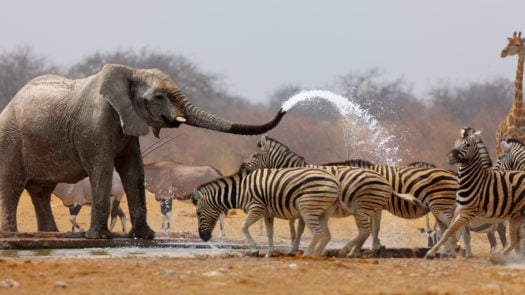
Where to Go on Safari between July and September
Crossings at the Mara River take place from August to October. This time of the year marks the peak season for migration safaris. Many of the herds can be seen crossing the border from Tanzania and into Kenya’s Maasai Mara National Park.
Another option is to head to Botswana to experience one of the premier wildlife habitats in the world: The Okavango Delta. Home to an enormous density and diversity of wildlife, the best way to enjoy it all is onboard a mokoro canoe.
There is also Zimbabwe. September is the best time to go on safari in Zimbabwe to see large groups of elephants in the Hwange National Park and the UNESCO-protected national park of Mana Pools. The low scrub makes Mana an excellent walking safari destination and the pools perfect for canoe-based game spotting.
June to September also happens to be one of the best times to visit Rwanda and Uganda for gorilla trekking. During this dry season, the forest terrain is not as challenging as it is during the wet months and reduced humidity means fewer mosquitoes. Since gorilla groups are always on the move, you need to be accompanied by expert trackers for a chance of seeing them up close. Our team of travel designers can help you with that.
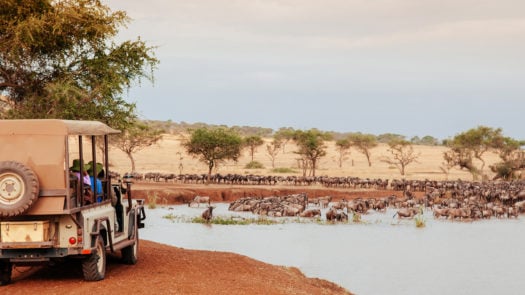
Where to Go on Safari between October and December
During the last few months of the year, the wildebeest make their way back into Tanzania, following the rain. In October, you can still catch a river crossing at the Mara River, but in general, game viewing becomes challenging. This wet season is ideal for birdwatching though.
Still in Tanzania, Singita Grumeti, the country’s largest private reserve, is great all year round. Not only do you have access to 350,000 acres of untouched wilderness, but the location is also incredibly exclusive.
Since this period represents the wet season in many parts of Africa, our travel designers often suggest alternative destinations for safaris. Although they offer a different experience, national parks in India have a high abundance of wildlife. Ranthambore and Bandhavgarh are open from October until the end of June.
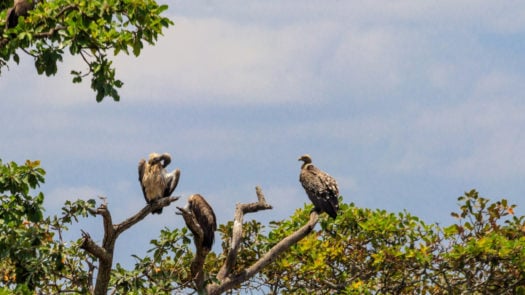
Get in touch to start building your safari adventure
Best Places for African Safari
The Top National Parks in Africa
1. Kruger National Park
Kruger National Park in South Africa is arguably the most iconic place to go on safari in Africa. The park is known for providing a good introduction to African wildlife, specifically the Big Five. This is the ideal location for safari first-timers and families.
When is the Best Time to Visit Kruger National Park?
The best time to visit Kruger National Park is during the dry season between May and October. Dry weather conditions, shorter grass and fewer watering holes mean better visibility for wildlife viewing.
The wet summer season in South Africa lasts between October and May. During these months, the scenery at the Kruger turns green. This is the best time to visit the Kruger for birding. Keep in mind that during this season, it gets hot and humid and you will want to consider malaria prevention.
Read more about the best time to visit South Africa and the Kruger.
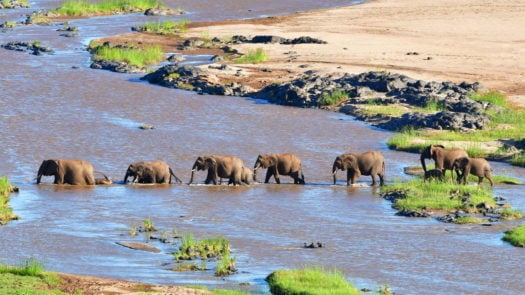
What Animals Can I See in Kruger National Park?
In the Kruger National Park you can spot the iconic Big Five. The park is home to lions, buffalo, leopards, elephants and rhinos. There are over 500 bird species. You will also be able to see other African species as its watering holes attract zebras, hippos and giraffes.
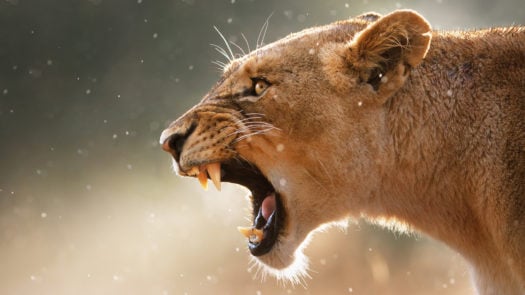
What is Special About Kruger National Park?
Kruger National Park is known for being one of the world’s oldest and largest wildlife reserves. It has an abundance of animal species ranging from the Big Five to giraffes and zebras. It is one of the best places to spot leopards.
The park is equipped with world-class facilities and accommodation options fit for all types of travellers. Within Kruger, you can also find private concessions like Singita Concession. There are some remarkable safari lodges spread across the area. We recommend Singita Lebombo for incredible views of the park.
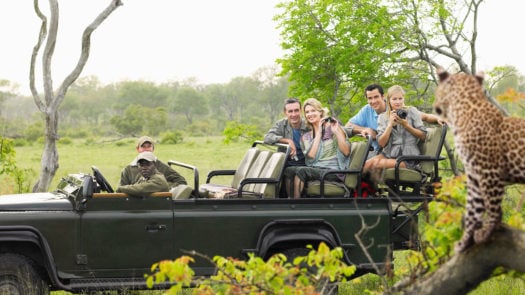
2. Serengeti National Park
The Serengeti National Park is located in Tanzania. It shares borders with Kenya’s iconic Maasai Mara. This is where you can spot one of the greatest shows on earth, the Great Migration, where millions of wildebeest, zebras and gazelles thunder across the Mara River.
When is the Best Time to Visit Serengeti National Park?
The best time to visit Serengeti National Park is during the Great Migration, particularly during the river crossings between August and October. Throughout this period, you can spot mega-herds of wildebeest traversing the Mara River into Kenya’s Maasai Mara.
February is the peak birthing season, with around 400,000 wildebeest born each year. Going on a safari in Tanzania during this time of the year allows you to spot some serious predator action. This is when you can see a high concentration of lions, cheetahs, leopards and raptors on the hunt for young wildebeest.
Read more about the Great Wildebeest Migration.
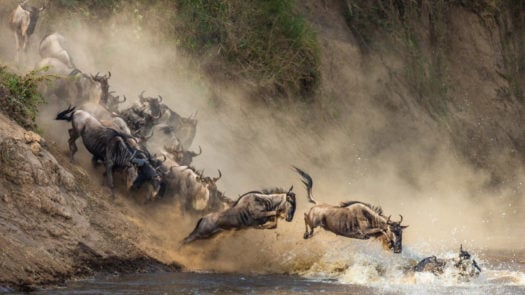
What Animals Can I See in Serengeti National Park?
The Serengeti is a great place to see a variety of wildlife, depending on which time of the year you visit. Between August and October, you can spot herds of wildebeest, zebras and gazelles. The peak birthing months of January and February attract predators.
Read more about the best time to visit Tanzania and the Serengeti.
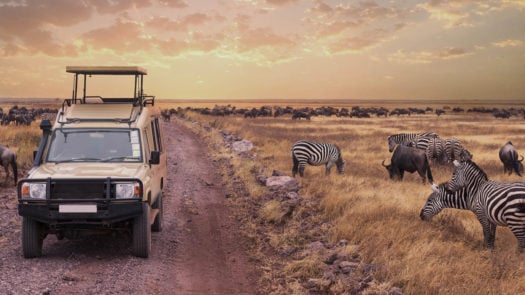
What is Special About Serengeti National Park?
Serengeti National Park is home to an iconic phenomenon, the Great Migration. Every year, approximately 1.5 million wildebeest, 400,000 zebras and 200,000 gazelles follow the rain. During this journey, they can be seen plunging into crocodile-infested waters, facing lions and other predators along the way.
It is also one of the best places to see big cat action, featuring cheetahs and leopards. And while it is true that you can spot the Great Migration in both Kenya and Tanzania, the herds spend most of the year in the Serengeti, therefore making it one of the most special places to see wildlife in Africa. It’s also often less crowded than the Maasai Mara which tends to be more popular among groups of visitors. The Serengeti also hosts some of Africa’s finest safari lodges, of which the Singita Mara Camp continues to impress.
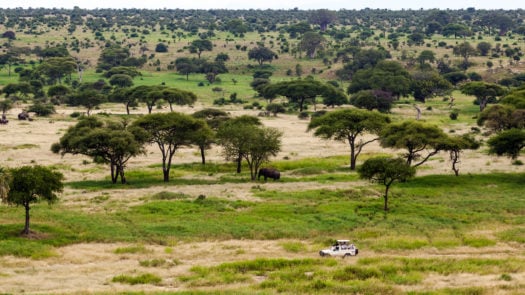
3. Volcanoes National Park
Located in Rwanda, Volcanoes National Park is the best place to visit for spotting endangered mountain gorillas in Africa. There are 10 habituated gorilla groups in Rwanda, all within this national park. Other than gorilla encounters, you can trek volcano craters and see golden monkeys.
When is the Best Time to Visit Volcanoes National Park?
June to September is the best time to visit Volcanoes National Park. During these drier months, fewer rain showers make conditions perfect for seeing the gorillas. If you want to explore the great outdoors we recommend avoiding the rainy season of March to May.
Read more about the best time to visit Rwanda for gorilla trekking.
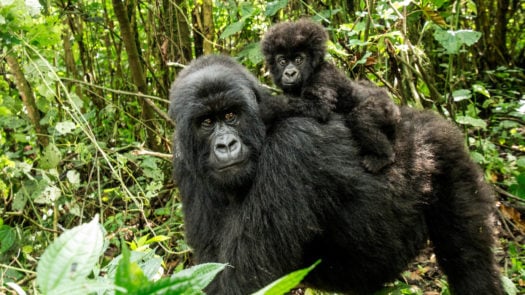
What Animals Can I See in Volcanoes National Park?
Volcanoes National Park is legendary for its primates. Other than gorilla sightings, you can see golden monkeys, bushbuck, spotted hyena and prolific birdlife. The national park is home to over 300 bird species. Today, you can also spot forest elephants in the national park.
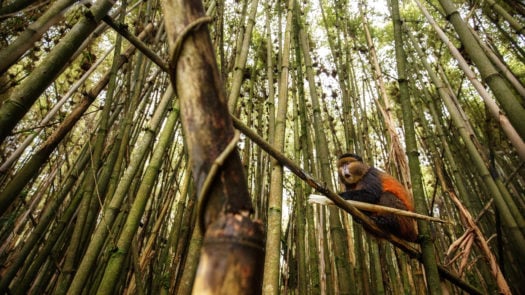
What is Special About Volcanoes National Park?
Volcanoes National Park is a first-choice destination for mountain gorilla safaris. It is one of the only places in the world where you can still spot great apes roaming freely. Its landscape is made up of dense forests and dramatic volcano craters.
What also makes the area special are the conservation efforts put in place to protect these fascinating creatures. The Fossey Fund is the world’s longest-running and largest organisation dedicated entirely to the conservation of gorillas. Some of their future plans include the development of the world’s first permanent, purpose-built gorilla research and education centre (which is set to be completed between 2021 and 2022). Adding to the national park’s allure is also the spectacular Bisate Lodge.
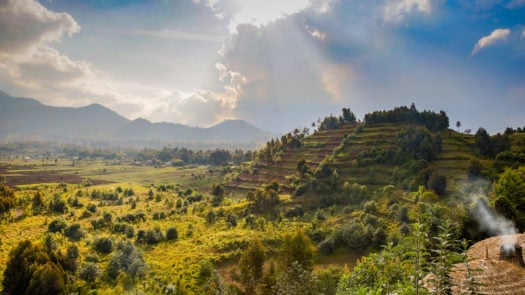
4. Maasai Mara National Reserve
The Maasai Mara sits in Kenya and is an atmospheric place to see the continent’s headline animals. In the Maasai Mara, you can witness the Great Migration. During the crossings at the Mara River, massive herds make their way from Tanzania’s Serengeti into Kenya.
When is the Best Time to Visit the Maasai Mara National Reserve?
The best time to go on safari in the Maasai Mara is during the river crossings. Many of the herds can be seen crossing the border from Tanzania and into Kenya’s Maasai Mara National Park. Crossings at the Mara River take place from August to October.
July to August is possibly the best time to catch the action in Tanzania’s Grumeti and September is best on the Mara side. That said, there can be no guarantee that you’ll see a crossing on your Great Migration Safari, but the best way to maximise your chances is to plan your trip with our experienced team.
Read more about the Great Wildebeest Migration.
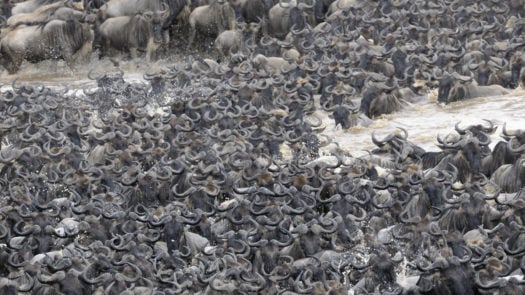
What Animals Can I See in the Maasai Mara National Reserve?
The Maasai Mara is one of the best African safari destinations to spot the Big Five (elephants, lions, leopards, buffalos, and rhinos). During the Great Migration, you can see some of the most fascinating African species too. Predator sightings are exceptionally great during river crossings.
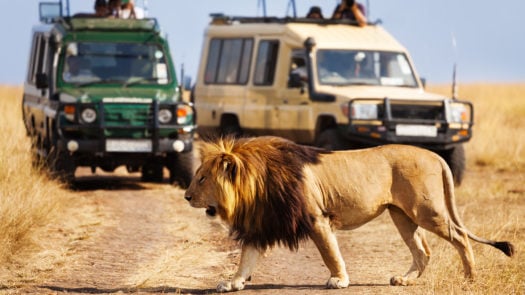
What is Special About the Maasai Mara National Reserve?
The Maasai Mara hosts the annual Great Migration. This wildlife spectacle can only be seen in two parts of Africa, namely Tanzania’s Serengeti and Kenya’s Maasai Mara. It offers exceptional birding, big cat action and is an all-in-one destination for first-timers looking to get acquainted with the safari scene.
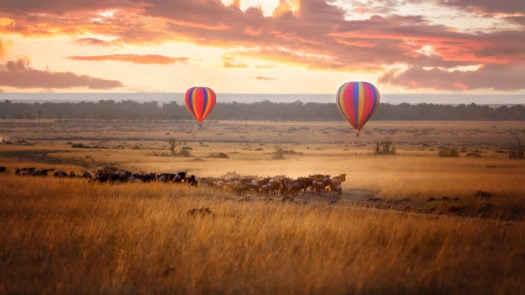
5. Moremi Game Reserve
Moremi Game Reserve is one of the oldest protected areas in Botswana’s Okavango Delta. It is made up of a unique combination of land and water, with floodplains, waterways, lagoons, pools, pans, grasslands and forests. The Moremi is home to the most endangered species of large mammals.
When is the Best Time to Visit Moremi Game Reserve?
The best time to visit Moremi Game Reserve is during the late dry season. Between July and October, the Okavango Delta reaches its highest levels. This time of the year is great for wildlife viewing as animals congregate along the waterways.
Read more about the best time to visit Botswana for safaris.
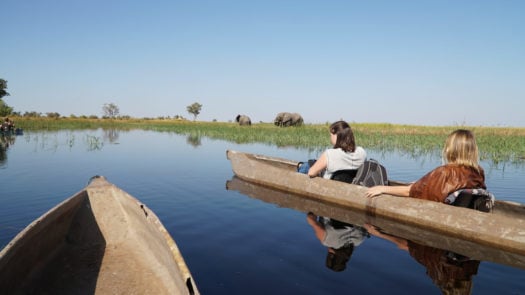
What Animals Can I See in Moremi Game Reserve?
With the recent re-introduction of black and white rhinos, Moremi Game Reserve is now a Big Five destination. You can see elephants, lions, leopards, buffalos, and rhinos. Giraffes, cheetahs, hyaenas, and nearly 500 species of bird also call the Moremi home.
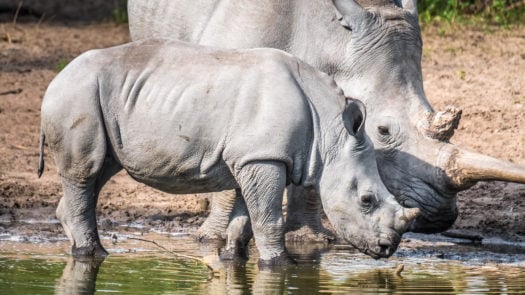
What is Special About Moremi Game Reserve?
A combination of land and delta means Moremi’s ecosystem is amongst the richest in Africa. In the Moremi Game Reserve, you can experience more than just traditional game drives. You can board a traditional mokoro canoe for a water safari and spot species unique to the area.
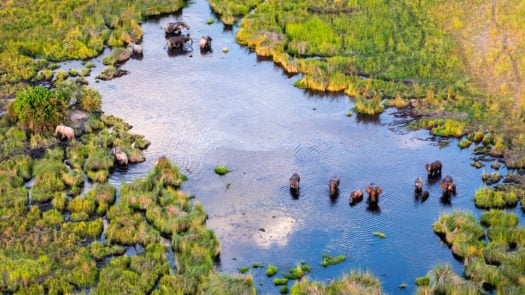
6. Hwange National Park
Hwange National Park is situated in Zimbabwe. It is one of Africa’s top national parks. Its landscapes make for exceptional animal sightings, especially during the dry season of June to October. The park is known as one of the best places in the world for elephant viewing.
When is the Best Time to Visit Hwange National Park?
The best time to visit Hwange National Park in Zimbabwe is during the dry season. Between June and October, animals congregate at the watering holes. This is the perfect time to spot big herds of elephants. The wet season between November and April is best for birdwatching.
Read more about the best time to visit Zimbabwe.
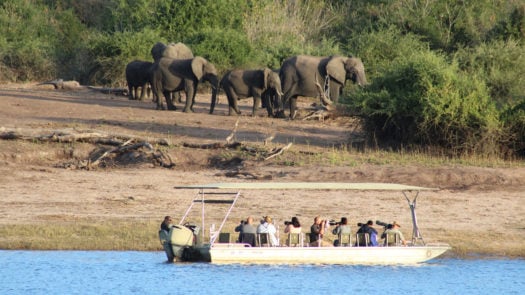
What Animals Can I See in Hwange National Park?
Zimbabwe’s Hwange National Park is particularly known for its herds of elephants. It is also home to one of the largest populations of African wild dogs. There are over 100 mammals and 400 different bird species. The park is also home to the Big Five.
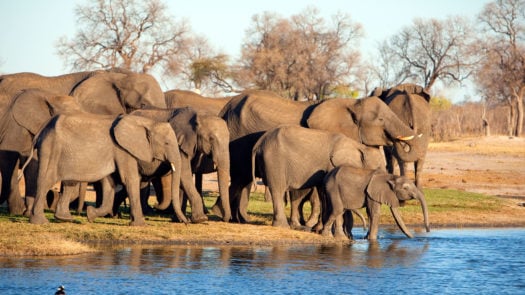
What is Special About Hwange National Park?
Hwange is Zimbabwe’s largest national park. It is one of the best places in the world to see mega herds of elephants roaming freely. There are approximately 20,000-50,000 elephants within the park. It is also one of the most diverse national parks in Africa.
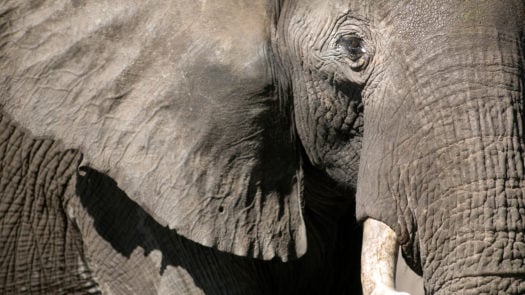
Best Luxury Safari Lodges in Africa
Africa’s collection of luxury safari lodges is just as wide and varied as the continent itself. But according to our travel designers, some are better than others.
1. Tswalu
Not only is Tswalu South Africa’s largest private game reserve, it is also a malaria-free haven that’s ideal for families. Added to that, sustainability lies at its heart. What makes Tswalu even greater is it’s low-impact approach. The reserve’s only two accommodation options, namely Motse Camp and Tarkuni House, welcome a limited number of 28 guests at a time. That way, you’re guaranteed absolute privacy and exclusivity.
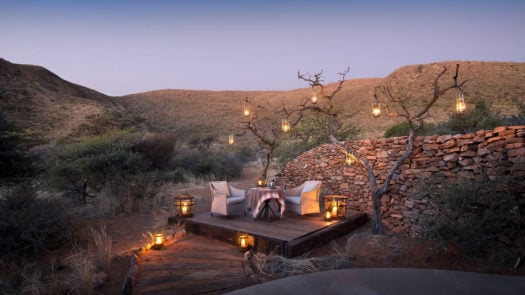
2. Angama Mara
Hidden in Africa’s Great Rift Valley, embedded in Kenya’s lush greenery, at Angama Mara you’ll be enthralled by the panoramic views of the Maasai Mara. Being at one with nature is effortless here. Every tented suite at Angama offers incredible vistas of the Mara below, which means possible front row seats to one of the greatest shows on Earth – The Great Migration.
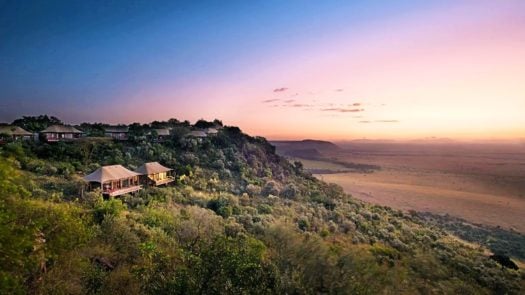
3. Singita Sasakwa
In Tanzania, Singita Sasakwa is the epitome of luxury. Made up of ten opulent cottages, the safari lodge is set in the country’s largest private reserve, Singita Grumeti. Come the months of June and July you can enjoy wonderful sightings of the wildebeest and zebra migration as it makes its way north through the reserve.
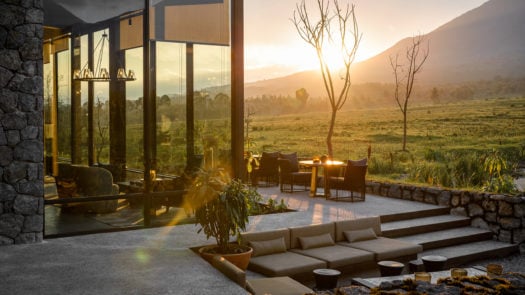
4. Mombo Camp
Tipping the indulgence scale, Mombo Camp in Botswana features plush tents, each equipped with a private plunge-pool. All of them are set right in the middle of the world-renowned Okavango Delta, home to some of the rarest species in Africa. In addition to traditional game drives, guests can experience cultural immersion in a ‘boma evening’ of local folk song and dance.
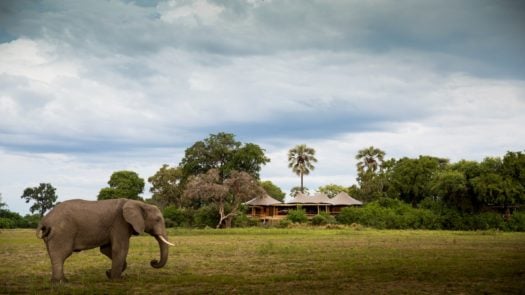
5. DumaTau and Little DumaTau
Sitting right in the middle of Botswana’s elephant-filled Linyanti Reserve, DumaTau and Little DumaTau offer easy access to the Linyanti floodplain as well as the Savuti Channel. This means, countless opportunities to spot the iconic Kalahari elephants. The marshes and forests are also home to roan and sable antelopes, hippos, crocodiles and wild dogs, to name just a few. Predator action is also good year round. And all of this is complemented by culinary journeys that offer some of the best farm-to-kitchen cuisine, showcasing the area’s top local purveyors.
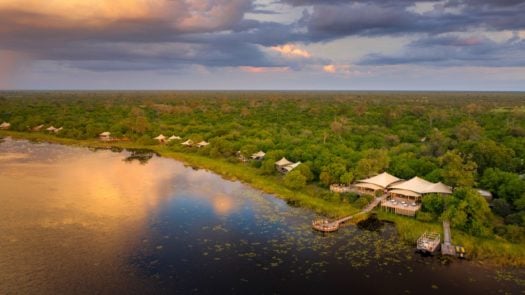
6. Hoanib Desert Camp
With landscapes that make you feel like you’ve left planet Earth, it’s no surprise that Namibia is home to some of the finest safari lodges in Africa. But Hoanib Desert Camp stands out from the rest. Get whisked off by a light aircraft and find yourself in this utterly isolated luxury lodge on the Skeleton Coast. Just seven twin-bedded suites and one family unit hide in plain sight.
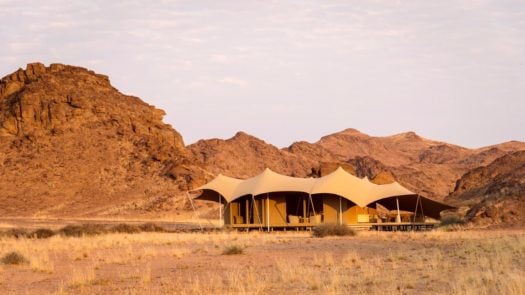
7. Bisate Lodge
Resembling giant bird nests, Bisate Lodge surely draws attention in Rwanda. The architecturally inventive safari lodge, guarded by Volcanoes National Park, sleeps 12 in a collection of six opulent en-suite Forest Villas. Undoubtedly, the focal point at this property is the fact that mountain gorillas roam its surroundings.
